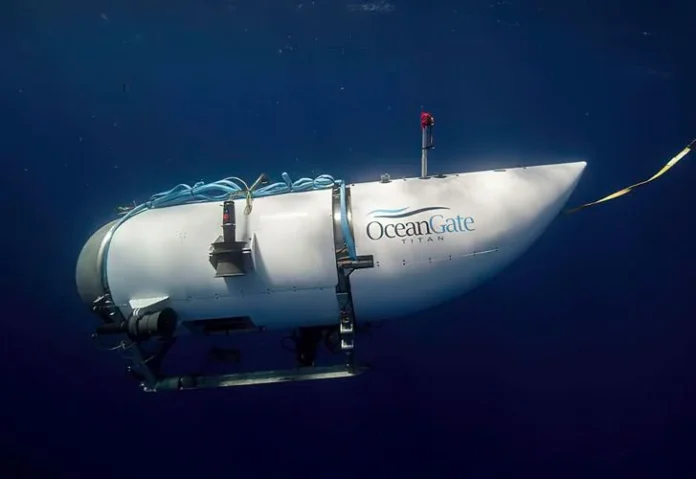WASHINGTON (AFP)-In a dramatic turn of events, the US Coast Guard announced that “underwater noises” have been detected during the search for a missing tourist submersible near the wreckage of the Titanic. The submersible, which had lost contact more than two days ago, is running out of oxygen, raising concerns for the five individuals on board.
Communication was abruptly lost with the 21-foot craft during its descent to explore the remains of the ill-fated British passenger liner, resting over two miles below the surface of the North Atlantic. The US and Canadian coast guard have deployed ships and planes to scour an expansive search area spanning 7,600 square miles (around 20,000 square kilometers) for the submersible. This search area is larger than the US state of Connecticut and is situated approximately 400 miles off the coast of Newfoundland, Canada.
The US Coast Guard’s First District reported that Canadian aircraft detected underwater noises in the search area, prompting a relocation of remotely operated vehicle (ROV) operations to investigate the origin of the sounds. Despite intensive efforts, the ROV searches have yet to yield any results. However, the search will continue, with US Navy experts analyzing the data shared by the Canadian aircraft to devise future search plans.
The submersible, named Titan, was carrying three fee-paying passengers, including a British billionaire and a Pakistani tycoon with his son. Titan, roughly the size of an average truck, belongs to OceanGate Expeditions, which charges $250,000 for a seat on the sub. The US Coast Guard’s announcement provides a glimmer of hope that those on board may still be alive.
International assistance has poured in to aid in the rescue mission. Specialized equipment, including a winch system for extreme depth lifting, along with additional personnel, is scheduled to join the ongoing rescue effort. The US Navy is deploying a third C-130 aircraft and three C-17s, while France’s oceanographic institute is dispatching a deep-sea underwater robot and its experts to the area.
Captain Jamie Frederick of the US Coast Guard emphasized the complexity of the search, acknowledging the challenges of coordinating and deploying assets in a timely manner. The rescue teams estimate that the passengers have less than two days’ worth of oxygen remaining, as the submersible is equipped to hold emergency air for up to 96 hours.
Meanwhile, concerns have been raised about the safety of the Titan submersible, as a 2018 lawsuit revealed allegations from OceanGate Expeditions’ former director of marine operations. The ex-director raised concerns about the “experimental and untested design of the Titan,” which he claimed led to his termination. The submersible lost contact less than two hours into its descent. On board are individuals such as Briton Hamish Harding, Pakistani businessman Shahzada Dawood, his son Suleman, OceanGate Expeditions CEO Stockton Rush, and French submarine operator Paul-Henri Nargeolet, famously known as “Mr. Titanic” for his frequent dives at the site.
The perilous nature of the mission was evident in a message posted on Instagram by Harding just before the journey, where he highlighted the rare opportunity presented by a break in Newfoundland’s severe winter weather. He mentioned that this mission was likely to be the sole manned visit to the Titanic in 2023. Harding, no stranger to daring adventures, holds three Guinness world records and previously ventured into space as a tourist through Jeff Bezos’s Blue Origin company.
As the search intensifies, experts speculate on the fate of the Titan submersible. Alistair Greig, a professor of marine engineering at University College London, hypothesized two potential scenarios based on images of the sub. One possibility is that the submersible encountered electrical or communications issues, causing it to surface and remain afloat until found, as it can only be unlocked from the outside. Another, more concerning scenario involves the pressure hull being compromised, resulting in a leak that poses significant risks to those inside.
The race against time continues as rescuers and experts collaborate to locate the missing tourist submersible and ensure the safety of its occupants, while the world watches with bated breath.






